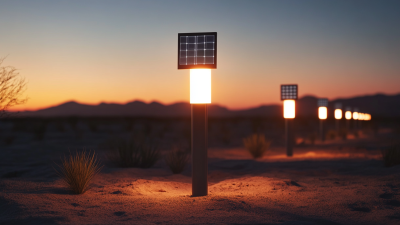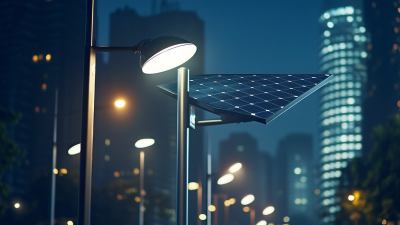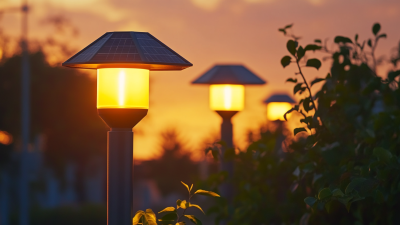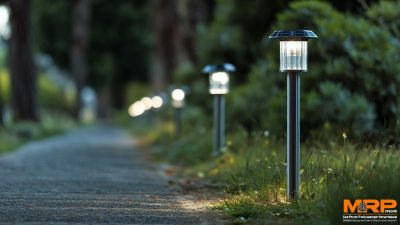How to Choose the Best Solar Powered Lights for Your Outdoor Spaces
As outdoor spaces become essential extensions of our homes, enhancing their ambiance and functionality has never been more important. One of the most effective and eco-friendly ways to illuminate these areas is through the use of solar powered lights. These innovative lighting solutions harness the sun's energy, providing a sustainable and cost-effective option for outdoor illumination. However, with the myriad of choices available in the market, selecting the best solar powered lights can be daunting. Factors such as brightness, design, durability, and ease of installation play crucial roles in making the right decision. In this blog, we will guide you through the essential considerations and tips to help you choose the perfect solar powered lights that will not only elevate the aesthetic of your outdoor spaces but also ensure they are practical and efficient.

Understanding Different Types of Solar Powered Lights for Outdoor Use
When selecting solar powered lights for your outdoor spaces, understanding the different types available can greatly enhance your decision-making process. Solar garden lights are among the most popular options. They come in various styles and can be strategically placed along pathways, in flower beds, or near garden features to add both safety and aesthetic appeal. These lights typically have stake-mounted designs, making installation easy without the need for wiring.
Another option is solar flood lights, which are ideal for illuminating larger areas such as driveways or patios. These lights produce a powerful beam of light and often come with adjustable settings for brightness and motion detection, providing security alongside functionality. Lastly, solar spotlights can be used to highlight specific features, such as trees or architectural elements of your home. By understanding these different types of solar powered lights, you can create a well-lit outdoor environment that complements your landscape while reducing reliance on traditional electricity sources.
Comparison of Different Types of Solar Powered Lights for Outdoor Use
Key Features to Look for in Solar Powered Outdoor Lighting
When selecting solar-powered lights for your outdoor spaces, several key features can significantly enhance both functionality and aesthetics. First and foremost, consider the brightness level. Measured in lumens, the brightness will determine how well the light illuminates your area. For pathways and gardens, look for lights that offer at least 100 lumens for adequate visibility.
Another important aspect is the type of solar panel used. High-efficiency solar panels absorb sunlight more effectively, leading to better performance even on cloudy days. Additionally, pay attention to battery capacity and lifespan; opt for models that feature lithium batteries, as they tend to have a longer lifespan and better energy retention.
Lastly, look for weather-resistant materials. Your outdoor lighting will endure various weather conditions, so choose lights that are constructed from durable materials like stainless steel or high-quality plastic. This ensures that your lights not only function well but also maintain their appearance over time. By focusing on these key features, you'll be well-equipped to choose the best solar-powered lights for your outdoor areas.
Evaluating Brightness and Color Temperature for Your Space
When selecting solar-powered lights for your outdoor spaces, evaluating brightness and color temperature is essential. Brightness, typically measured in lumens, determines how well the lights illuminate your area. For pathways or ambient lighting, 100-300 lumens may suffice, while areas requiring more visibility, such as driveways or security lighting, may need 300-800 lumens. It's crucial to balance brightness with your outdoor needs; too much light can create glare, while too little can render the space impractical.
Color temperature, measured in Kelvin (K), impacts the aesthetic of your outdoor space. Warm white lights (2700K-3000K) create a cozy and inviting atmosphere, perfect for relaxing areas like patios or gardens. On the other hand, cooler white lights (4000K-5000K) can enhance visibility and are ideal for task-oriented areas, such as workspaces or security lighting. When choosing, consider the overall vibe you wish to achieve; mixing different color temperatures can also add depth to your outdoor lighting design.
Tips: Always test the brightness of solar lights before buying, as manufacturers' lumens can vary. Additionally, choose solar lights with adjustable settings for versatility, allowing you to fine-tune brightness and color temperature according to different occasions or moods.

Selecting the Right Placement for Maximum Sunlight Exposure
When selecting solar powered lights for your outdoor spaces, the placement of these lights is crucial for ensuring they receive maximum sunlight exposure throughout the day. Begin by evaluating your yard or garden to identify areas that receive the most sunlight, ideally at least six hours of direct sunlight daily. South-facing spots, away from large trees or structures that may cast shadows, are often the best candidates for solar light installation.
Next, consider the lighting purpose in each area. For pathways, choose lights with a lower profile that won’t obstruct sunlight. In contrast, uplighting features can highlight trees or architectural elements and should be positioned where they can catch sunlight from various angles during the day. Remember, adjusting the angle of the solar panels, if possible, will also enhance their exposure and improve the efficiency of your solar lights. By strategically placing your solar lights to maximize sunlight absorption, you not only ensure a well-lit outdoor space at night but also prolong the life and performance of your solar lighting system.
How to Choose the Best Solar Powered Lights for Your Outdoor Spaces - Selecting the Right Placement for Maximum Sunlight Exposure
| Type of Light | Ideal Placement | Max Sunlight Exposure (hours) | Best Uses |
|---|---|---|---|
| Pathway Lights | Along walkways and garden paths | 6-8 hours | Illuminating foot traffic |
| Spotlights | Highlighting trees, sculptures, or architecture | 5-7 hours | Focal points in landscapes |
| String Lights | Above patios or in trees | 6-8 hours | Creating a festive ambiance |
| Wall Lights | On fences or house walls | 4-6 hours | Lighting up entrances or stairways |
| Flood Lights | Wide open areas like backyards | 6-10 hours | Security and large space lighting |
Comparing Cost-Effectiveness and Longevity of Various Solar Lighting Options
When selecting solar-powered lights for your outdoor spaces, it's crucial to evaluate not only their aesthetic appeal but also their cost-effectiveness and longevity. The rapid advancements in photovoltaic technology have significantly enhanced the performance and efficiency of solar lighting options. Recent studies highlight the importance of understanding how environmental factors impact the longevity of solar products, illustrating that installations can suffer performance losses ranging from 60% to 70% under adverse conditions. Therefore, it's essential to consider models that include features like wind-induced cooling to mitigate these effects and ensure they last longer.
In addition to longevity, cost-effectiveness must also be a priority. A comprehensive review of various solar lighting systems reveals that while some options may be cheaper upfront, their overall lifetime costs can escalate due to maintenance and replacement needs. Therefore, performing a thorough cost-benefit analysis of different solar lights can help identify which products offer the best return on investment. By focusing on durable designs with superior technology, homeowners can enhance their outdoor experiences while being mindful of both economic and environmental sustainability.

Related Posts
-

Illuminate Your Space Sustainably: Discover the Benefits of Modern Solar Lights
-

The Rise of Solar Powered Lights in Sustainable Urban Development
-

The Evolution of Solar Lamps: Illuminating a Sustainable Future
-

7 Top Features of the Best Solar Powered Lights That Every Global Buyer Should Know
-

Unlocking Sustainability with Solar LED Lights Advantages for Your Home and Business
-

Exploring Eco Friendly Alternatives to Solar Powered Outdoor Lights for Sustainable Living
